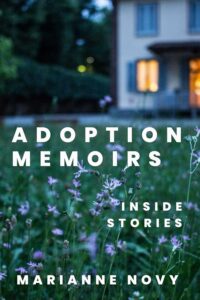 A Literary Reflection by Rosemary Starace
A Literary Reflection by Rosemary Starace
As an adopted person myself, hopeful and concerned about how adoption is viewed by society, I was eager to delve into Marianne Novy’s new book—a careful, caring survey of 47 first-person stories from birth mothers, same-race and different-race adoptees, and adoptive parents. She finds “moving portrayals of grief, anger, courage, persistence, joy, learning, and forgiveness” and presents them in the hope that these real stories help readers understand “the complexity of emotions… [and] the complexity of social justice issues adoption can pose” (both 15).
Novy, also an adoptee, is Professor Emerita of English and Gender, Sexuality, and Women’s Studies at the University of Pittsburgh and author of Reading Adoption: Family and Difference in Fiction and Drama and editor of Imagining Adoption: Essays on Literature and Culture. In Adoption Memoirs, Novy pulls out significant themes within and among the groups, finding that the memoirs speak to each other (beseechingly or instructively, intentionally or not) and to anyone contemplating adoption or contending with its outcomes.
She considers narratives from my own era, the mid-twentieth century, where we hear from birth mothers who were sent away in shame and adoptees kept in the dark about their origins, their pain and questions dismissed. (I didn’t know my own ethnicity until I was an adult.) This is followed by a look at stories of more recent suffering: different-race adoptees, who in addition to lost family and cultural connections contended with blatant racism. (Here, one’s ethnicity is in the foreground, yet often cut off, beyond reach.) Throughout, Novy finds evidence of lasting pain among birth mothers and adoptees and of continuing challenges adoptive parents face as they try to nurture children who are theirs but not theirs. Something that stands out for me: even today, all parties touched by adoption struggle within society’s ignorance and lack of support.
Novy’s painstaking pattern-seeking moved me, and I found myself thinking not only about the individual stories and what it meant to have lived them, or how they did or didn’t relate to mine, but also about how adoption stories reflect and magnify universal human patterns. As A.M. Homes is quoted, “The quest to answer the question Who am I? is not unique to the adoptee” (126). Indeed, this is the question at the heart of philosophy, religion, art, and even the trials of whole societies, like our own.
Reunion is another such pattern, and a major motif in these memoirs—not only the reunion of long-separated relatives, but also the slow return of one’s own lost feelings and qualities. Again, who doesn’t long to reclaim the parts of oneself that had to be left in a basket outside a gate? Several of the memoirs from each of the groups recount these shifts in attitude that can accompany maturation—as with Jackie Kay, an adoptee, who finds, after a life of searching, writing, and pursuing meaning, that she “is no longer double” (129). This echoes my own experience; to become “unseparated” within is what I truly desired, and though my own reunion with family was of lasting import, it is the psycho-spiritual and creative work I did along with it that supports my wholeness.
Adoption, as presented here, reminds us, too, that love is not only patient and kind but also spacious. Novy quotes adoption writer Angela Tucker (whom Novy calls “an expert in paradox”), who tells adoptees that we “can love more than one set of parents” (both 136). Expanded, it’s a reminder that all humans can love people who are kin and not kin, who are like us and not like us. We can embrace what first seems “other,” without and within. In this way, identity, too, can expand. Adoptee Mei-Ling Hopgood comes to feel part of “a collective tapestry so intricate that one string cannot be untangled from the other” (126).
That we all must grapple with similar knots around love, self-love, and identity helps adoption’s story get pieced back into our larger, human one, increasing empathy and understanding. Novy’s informed and patient scholarship does exactly this—and it matters greatly in the long effort towards reform. Jackie Kay states that “being adopted never ends” (126). Nor does adoption’s larger story. Novy tells us at the end of her book that she wants it to be “a beginning” (190) towards replacing the simplistic with the real, the fairytale with the difficult but relatable truth. Adoption’s great epic becomes more intelligible and accessible each time a new story or a new view, like the one Novy gives us, is sewn in.
Adoption Memoirs: Inside Stories, Marianne Novy
Temple University Press, 2024, 262 pp.,
$32.95 paper, 97814399259
Rosemary Starace is a writer and visual artist, and an adopted person. She’s written on adoption online at Poets on Adoption and in her poetry book, Requitements. She was also co-editor of Letters to the World, an international poetry anthology representing the Women’s Poetry Listserv. Her recent exhibit “In-Dwelling” looked at the house as symbol of refuge and belonging, and her process often involves collage—joining disparate things to make a new, meaningful whole.
